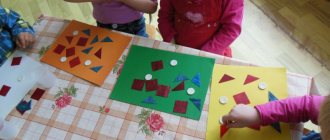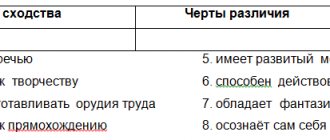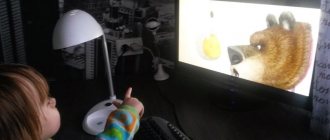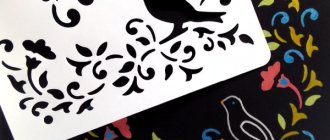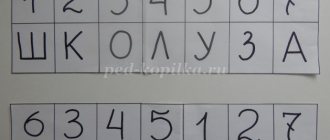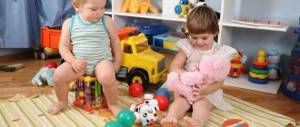Travel activities
Materials found: 134 Shown: 1 - 10
Abstract of the GCD “What surrounds us”
WHAT SURROUND US Topic: What is the man-made world? Goal: to consolidate the ability to correctly name objects of the man-made world; teach children to group objects by method of use (correctly determine the function of an object) and understand...
Lesson summary: “Hello world.” Topic: “Travel to Africa.” Preparatory group. Program "School 2100"
Preparatory group. Lesson: “Hello World” Topic: “Travel to Africa” Problems: 1) Can an ostrich fly? 2) Why does an ostrich need wings? 3) What do bananas grow on? Goal: To develop children’s creative cognitive…
Summary of direct educational activities. "Autumn Fair"
Goals: to generate interest in the fair. Objectives: To summarize and systematize ideas about autumn according to the main, essential features, to consolidate knowledge about a person’s autumn preparations for winter in the garden. Activating the dictionary for...
Summary of physical education classes with children with disabilities. "Walk in the autumn forest."
Summary of a physical education lesson with children with disabilities (CHD) 1st year of study “Walk in the autumn forest.” Goal: Strengthening children's health. Objectives: 1) Teach children to combine physical activity and...
Topic: “Journey to the Homeland of the Tomato”
Lushnikova M. V., teacher of the 2nd qualification category of the MKDOU D/s “Cherry”, Vargashi village. Topic: “Journey to the homeland of the tomato.” Software tasks. Educational: to give children an idea of the plant’s need for light, ...
Physical education lesson notes
MUNICIPAL BUDGETARY PRESCHOOL EDUCATIONAL INSTITUTION COMPENSATING KINDERGARTEN No. 24 “COSMOS” Summary of direct educational activities in physical education in senior speech therapy…
Music lesson (for certification) in the preparatory group. “Let’s fill the country of Harmony with music”
Musical director. Slide 3 Guys, today our activity is unusual. The fact is that today I received a letter from Domisolka, the princess of a musical country. You, of course, remember our travels through the cities of this wonderful...
Summary of a lesson on environmental education in junior group 1: “Mother for a kitten”
Topic: Mother for a kitten Goal: 1. Give children an idea about domestic animals and their young (cats, kittens, cows, horses, dogs, etc.) 2. Introduce them to Russian life 3. Develop a kind attitude towards animals Materials: Panorama…
Summary of GCD on life safety for children of senior preschool age. “Is fire your friend or foe?”
Program objectives: Educational: • To introduce children to the good and evil deeds of fire. Tell him that he has long been a friend of man. • Expand and clarify children's knowledge about fire safety rules in everyday life. ...
Direct educational activities. Cognition (FEMP). "Space trip"
Scenario of direct educational activities.
“Cognition” (formation of elementary mathematical concepts. Speech therapy preparatory group. “Space travel” Goals: Educational. Strengthen counting... Pages : ...
Travel activities are one of the favorite activities for children. There are a lot of travel options - these include walks through fairy tales, excursions around their native land, hiking in winter or spring forests, flights to other planets or visits to fantastic magical lands of letters and numbers.Children themselves often act as a guide.
All sections
Integrated lesson “Travel on the Miracle Engine”
Target.
1. Continue to develop verbal communication skills with each other.
2. Teach children to tell, explain, freely express the course of their actions, prove their point of view.
3. Consolidate knowledge about the names of fairy tales and the characters who live in these fairy tales; about the elements of Petrikov painting.
4. Activate children's active vocabulary.
5. Develop the child’s emotional sphere by using knowledge about emotions and feelings, aesthetic perception, and creative abilities through theatrical activities.
6. Foster a culture of relationships between children, a desire to help others, sympathize, and empathy.
Material: model of a train, musical accompaniment: locomotive whistle, sounds of the forest, rural motifs, spring fairy tale; d/i “Shadows”, d/i “Petrikovskaya Painting”, d/i “Daisies of Mood”, d/i “Choose an Illustration for a Fairy Tale”, “Spring Tale”, costumes: spring, sun, butterfly, bug, frog, bears, flowers, geese.
Progress of the lesson.
I gather the children in a circle.
Educator. Children, look at me and show me your eyes. Let's smile at each other and give a good mood.
Children, I really love fairy tales, and you?
Today I want to offer a trip to the “Magic Land of Fairy Tales”.
How can we get there?
Children's answer options.
Educator. So, children, there are a lot of vehicles, but we will get there on a magic train. Look how funny and wonderful he is. We stand behind each other, so we took our places in the trailers.
Go!
Engine whistle.
Children imitate the movement of trailers.
Educator. Our train made a stop. Listen, what do you hear, so where did we leave off?
Sounds of the forest.
Educator. So, children, we ended up in the forest. Who lives in the forest?
What happened here? Why don’t I see a single resident here, what do you think?
Our little engine tells me that an evil wizard visited here and charmed all the animals, turning them into shadows.
D/i “Shadows”: connect a shadow with a cord to the desired animal - a forest dweller.
If you complete the task correctly, then we will help all the animals and they will return to the forest.
Children complete individual tasks.
Steam locomotive whistle.
Educator. Completed the task. Well done! The Engine is calling us further. Go! The locomotive made a stop. What do you hear?
Rural motives.
Who lives in the village, do you think? Children's answers.
There are unusual houses in the village, with various shutters, and there is a wonderful design on the shutters. Let's look at it.
D/i: “Petrikovskaya painting”: children lay out elements of Petrikovskaya painting on the shutters, decorating the window.
I suggest everyone decorate a window with shutters.
Completing tasks.
Educator. Well done! You did a wonderful job. Let's not hesitate, let's move on.
Engine whistle.
Educator. We stopped at a chamomile field. Look how many flowers there are. Don't they remind you of anything?
D/i “Mood Daisies”: name the mood of each daisy.
Children, you correctly named the mood of the daisies. They are funny, sad, surprised, and mysterious.
Why do you think daisies are in a sad mood?
That's right, they don't have enough water. There is a lake next to the clearing. Let's give water to every daisy in the clearing.
Close your eyes, imagine what the water is like: clear, cool, wet, alive.
You helped the daisies, well done!
The Engine is calling us further.
Engine whistle.
Children, this is our last stop - the Land of Fairy Tales. As you may have guessed, there are different fairy tales in this country, there are a lot of them. But an evil wizard visited here too and mixed up the fairy tales. Shall we help them?
D/i “Choose an illustration for a fairy tale”: children select a card based on eidetics for stories from fairy tales.
Well done! Everyone completed the tasks correctly. And now I invite you to turn into fairy-tale characters yourself and play in a fairy tale. You are artists, I am a storyteller. Look what costumes I have prepared. Choose your own costume according to your wishes, whoever wants to be who.
I want to remind you that when you hear me name your hero, come out into the circle and, using movements, facial expressions, and gestures, show the actions that I will talk about in the fairy tale.
"Spring Tale"
The gentle, warm sun came out. It floated across the sky. It warmed the whole earth and insects and animals woke up from its warmth. Bugs and butterflies crawled out of their hiding places. The ground was covered with green grass and bright flowers grew in the clearing. A light wind blew and the flowers shook their heads, and bugs and butterflies flew around the flowers and shook their heads. The sun warmed the water in the lake where the frog lived. She jumped out of the water and chirped throughout the forest, greeting her friends - the goslings. The geese answered the frog and flapped their wings. Hearing a noise near the lake, bears came out of the forest. They shifted from paw to paw, greeting all the forest inhabitants. When everyone gathered in a forest clearing by the lake, they saw that the beauty Spring was coming to the meeting and giving everyone a gentle smile.
What a wonderful fairy tale we have created. You are wonderful artists and therefore we will give each other applause and smiles.
Today you were very active and attentive. Completed all tasks assigned to you correctly.
I want to thank you for your fruitful work.
I taught classes to middle school children.
There were 9 children present.
The topic of the lesson is “Travel on the Miracle Engine.” This activity is integrated and includes educational areas: cognition, socialization, fiction, artistic creativity, music, theater. To achieve increased speech activity, I used a lesson based on game motivation. When planning the lesson, I set a pedagogical goal:
- activate mental abilities;
- logical thinking;
- Creative skills;
- develop the ability to conduct dialogue.
To achieve this goal, the following tasks were identified:
Educational:
• develop verbal communication skills with each other;
• children’s ability to tell, explain, prove, creatively and proactively approach problem solving;
• realize knowledge about the elements of Petrikov painting.
Educational:
• develop analytical, aesthetic perception, persistent attention;
• memory, speech, creativity through theatrical activities.
Educational:
• create positive motivation in class;
• cultivate a culture of relationships;
• self-control of your speech;
• desire to help others.
The lesson used the integration of educational areas in accordance with the age characteristics and capabilities of the students. The material for the lesson was selected taking into account a logical sequence, from simple to complex. At all stages of the lesson, mental, cognitive, and creative activity intensified. This gradual change of activities at each stage made it possible to prevent children from becoming tired. During the lesson, a clear structure of construction was observed in accordance with the program tasks. The playful method of travel that I chose contributed to the motivational activity of the children.
Stage 1 of the lesson - organizational, introduction to the game situation, setting goals for the lesson. To relieve emotional stress in children, I used the “contact” psycho-gymnastics technique, and the use of a game technique allowed me to include children in educational activities at a personally significant level, due to the emergence of an internal need for activity in them.
Stage 2 – optimization and implementation of basic knowledge by means of actions, mental operations of independent and joint activities with me. As part of this stage, children's knowledge about animals and decorative painting was consolidated, and children's knowledge about fairy-tale characters was confirmed. When conducting this part of the lesson, I used visual, verbal, practical methods aimed at activating speech, cognitive, practical, creative skills and abilities. To achieve better performance results, I used materials with eidetic elements, theater attributes, and illustrations of fairy tales. This set of methods made it possible to increase the effectiveness of classes. During the lesson, I tried to use a variety of techniques: questions, verbal explanations of actions, doing practical work in pairs and with each child. I believe that the use of methods and techniques allowed me to direct children’s attention to cognitive interest and relieve children’s fatigue.
Stage 3 – the result. Analyzing the children’s actions during the lesson, I would like to note that throughout the lesson, with my help, the children assessed the results of their activities and skillfully used previously acquired knowledge and skills. They were active and showed interest. During the lesson, I monitored the children’s speech and the correct construction of sentences. In case of mistakes, she corrected them tactfully and intelligibly. During the lesson, I tried to build personality-oriented interactions with children, listen to each child, and create a situation of success for each of them. However, 2-3 children worked slowly and performed creative tasks worse. The reason for this was not their lack of knowledge and skills, but their individual abilities. They completed the assigned tasks, but late. The lesson was very intense. The completed tasks showed that the goal of the lesson was achieved. The children really enjoyed the activity and would like it to continue.
Author: Prudova Natalya Vladimirovna, teacher, KDU (nursery/kindergarten) “Ladushki” of the combined type of education department of the Rovenkovsky city council, Lugansk region.

